英语词汇学之构词法
词汇学之6种构词法

national clockwise slavery
--
5. Prefixes of attitude
prefixes
meaning
examples
co-
with
cooperate
counter-
against
counterattack
anti-
against
anti-clockwise
pro-
for
Backformation Sound reduplication
clipping acronymy
--
4.1 Affixation/derivation
• Affixation falls into two categories: prefixation and suffixation and the differences between them are just the differences between prefixes and suffixes.
post
industrial
graduate
war
--
7. Prefixes of time and order
prefixes fore-
meaning before
examples foresee
pre-
(完整版)英语构词法(常用的词根词缀总结)
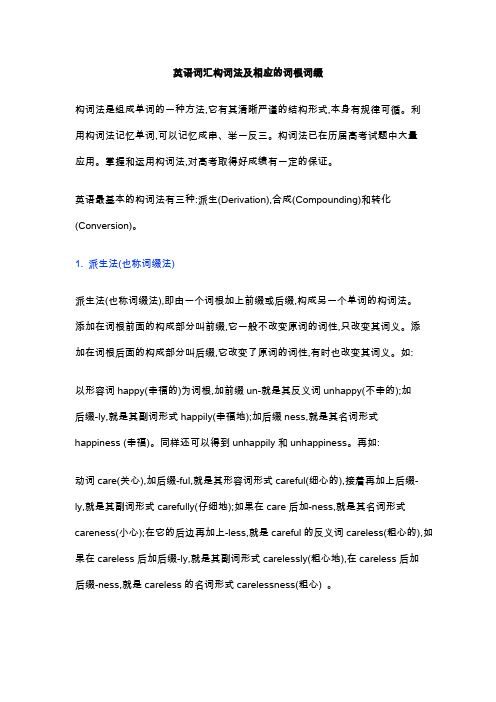
英语词汇构词法及相应的词根词缀构词法是组成单词的一种方法,它有其清晰严谨的结构形式,本身有规律可循。
利用构词法记忆单词,可以记忆成串、举一反三。
构词法已在历届高考试题中大量应用。
掌握和运用构词法,对高考取得好成绩有一定的保证。
英语最基本的构词法有三种:派生(Derivation),合成(Compounding)和转化(Conversion)。
1. 派生法(也称词缀法)派生法(也称词缀法),即由一个词根加上前缀或后缀,构成另一个单词的构词法。
添加在词根前面的构成部分叫前缀,它一般不改变原词的词性,只改变其词义。
添加在词根后面的构成部分叫后缀,它改变了原词的词性,有时也改变其词义。
如:以形容词happy(幸福的)为词根,加前缀un-就是其反义词unhappy(不幸的);加后缀-ly,就是其副词形式happily(幸福地);加后缀ness,就是其名词形式happiness (幸福)。
同样还可以得到unhappily和unhappiness。
再如:动词care(关心),加后缀-ful,就是其形容词形式careful(细心的),接着再加上后缀-ly,就是其副词形式carefully(仔细地);如果在care后加-ness,就是其名词形式careness(小心);在它的后边再加上-less,就是careful的反义词careless(粗心的),如果在careless后加后缀-ly,就是其副词形式carelessly(粗心地),在careless后加后缀-ness,就是careless的名词形式carelessness(粗心) 。
前缀、后缀是构词的要素,具有一定的作用和意义。
懂得了前后缀的含义,就容易了解由前(后)缀和词根结合而成的单词的意义。
现把英语中我们常见的前后缀列举如下:1)前缀anti-反对: antisocial反社会的auto-自: automobile小汽车,autonomy自治bi-双: biannual 一年两次的, bicycle自行车by-在旁:bystander 旁观者, by-product副产品co- 同: co-operation合作,co-existence共处,co-worker同事counter-反:counter-attack反攻,counter-revolutionary反革命的dis-否定,除去: discover发现,disorder混乱,杂乱en-使成为: enable使能够,enslave奴役, encourage鼓励extra-外: extraordinary非常的,格外的for-,fore-,先,前,预: forward向前,foresee 预见,forearm前臂,foretaste先尝for-禁,弃: forbid禁止,forget忘记,forgo放弃in-,il-,im-,ir-不,非: informal非正式的,incomplete不完全的,indefinite不定的, illegal非法的,immoral不道德的,irregular不规则的inter-间,相互:internationalism国际主义,interview会见micro-微: microscope显微镜,microfilm微型胶片mid-中:midday 中午,midnight夜半,mid-autumn中秋的mis-误: misunderstand 误会,misuse误用,misfortune不幸non-非,不:non-moral非道德范围内的,nonsense胡言,nonexistent不存在的post-后于: postwar战后的pre-先于: prewar战前的re-重,再,复: rewrite重写, return返回, review复习super-上,超: superman超人,supermarket 超级商场tele-远: telephone电话,telescope望远镜,television电视un-不: unable不能的,unimportant不重要的,untrue不真实的vice-副:vice-chairman副主席,vice-premier副总理2)后缀-age状态,集合: marriage婚姻, shortage缺少,village 村庄-an人: American美国人,Italian意大利人,意大利籍,African 非洲人-ation,-ition动作,状态:determination决心,industrialization工业化,preparation 准备,competition竞争,repetition重复-dom状态,领界: freedom自由,kingdom王国-eer人: engineer工程师,volunteer志愿者-er人,动作者:fighter战士,worker工人,writer作家,thinker思想家,harvester收割机-ese人,语言:Chinese中国人,中文, Japanese日本人,日文-ess女性:actress女演员,princess公主,goddess女神-hood身分,境遇,状态: childhood 童年,womanhood女性-ian人: musician音乐家, guardian卫护者, Christian基督教徒-ism主义,教:communism共产主义,socialism社会主义,revisionism修正主义-ist主义者,人: communist共产主义者, artist 艺术家-ity (抽象名词): possibility 可能性, ability能力,equality平等-man人: Englishman英国人,英格兰人, postman邮递员-ment运动,结果: movement运动,development发展,judgement判断-ness状态,性质:kindness和善,carefulness小心,correctness正确,tiredness疲倦-or人,动作者: actor男演员,visitor访问者-ship状态,身份: friendship友谊,comradeship同志之友谊,sportsmanship 体育道德,hardship苦难-sion动作,状态: tension紧张状态,revision修订-tion动作,状态: attention注意,action行动-less无:fearless 无所畏惧的,careless 不小心的,useless 无用的,meaningless 无意义的-ly品质,的: comradely 同志般的, friendly 友好的, weekly 每星期的-some引起,适于,易于: troublesome 烦人的,tiresome 令人感到厌倦的2. 合成法(也称复合法) 把两个单词或两个以上的词合成一个新词,这种构词的方法叫做合成法。
英语词汇学之构词法PPT课件

-en
woolen, golden, wooden, earthen…
-ent different, dependent, existent, consistent…
-ic
realistic, poetic, historic, economic…
November 18, 2023
14
常见后缀2—形容词后缀
11
常见后缀1—名词后缀
后缀 例词
-an
Asian, American, Russian, African…
-ance attendance, performance, assistance…
-ation education, examination, pronunciation…
-dom
freedom, kingdom, wisdom, boredom…
spy(监视)
lower(更低的) lower(降低)
1818
其它构词法之截短法
缺点
杂乱 不喜欢
10
常见前缀3—特定意思
构成方式
anti-(反) auto-(自动) bi-(双) centi-(百分之一的) co-(共同) down(向下) ex-(以前的) fore-(前部的) full-(完全) November 18, 2023
例词
antiwar, anticancer, antipollution… automatic, autotimer, auto-record… bicycle, binoculars… centimeter, centigram, centigrade… co-operate, co-edit, co-exit… downstairs, downhill, downwards… ex-wife, ex-lover, ex-husband… forehead, foreleg, forearm… full-time, full-speed, full-strength…
高中英语构词法

09
2.表示其他 意义的常见
前缀
nonprofessional 非专业的
01
(1)a ……的
asleep 睡着的 alive 活着的 awake 醒着的,清醒的
02 (2)en 使……
enable 使能够 enrich 使丰富 enlarge 扩大,使变大 endanger 危及 encourage 鼓励
(4)名词+动名词
02
handwriting 书法 sunbathing 日光浴
(5)动词+副词
03
gettogether 联欢会 breakthrough 突破
software 软件
(6)副词+动词
outbreak 爆发 output 输出
(7)代词+名词
hegoat 公山羊 shewolf 母狼
unfit 不合适的
unfit 不合适的
01
(2)in
02
03
invisible 看不见 的
inconvenient 不方便的
04
incorrect 不正 确的
05
06
07
08
informal 不正式 的
inaccurate 不精 确的
incurable 不可 治愈的
incomplete 不 完全的
unfit 不合适的
(3)im impractical 不实际的 (4)il impolite 不礼貌的
impossible 不可能的
immoral 不道德的
improper 不合适的,不恰
当的
illegal 违法的
illogical 不合逻辑的
imperfect 不完美的
常见英语构词法

英语词汇常见构词法
说明:英语词汇的构词规律一般可分为三种。
一是转换法(conversion),即由一种词类转换为另一种词类;如:walk(名词),也可用作walk(动词)。
二是合成法(composition),即由两个或两个以上的词合在一起构成的词,如:basketball,airport,go-between,brunch,Eurasia,Motel 等。
三是派生法(derivation),又叫词缀法(affixation),即在某些单词前或后加上前缀(prefix)或后缀(suffix)来构成新词。
其中,第三种方法比较普遍,掌握这些构词规律对于我们学习英语和理解记忆英语单词非常有帮助。
一、前缀(Prefix,一般改变词义)
1.表范围和程度
2.表方位、方向和态度
3.表否定
4.表逆反
5.表数字
6.表贬义
7.其他
二、后缀(Suffix,一般改变词性)
1.名词后缀
2.形容词后缀
3.动词后缀
4.副词后缀。
词汇学之构词法课件

目录
CONTENTS
• 构词法简介 • 前缀构词法 • 后缀构词法 • 合成词构词法 • 转化词构词法 • 总结与展望
01 构词法简介
什么是构词法
01
构词法是研究词汇变化和形成的 科学,它主要研究词素组合的方 式、词素替换的规则等。
02
构词法包括词根、前缀、后缀、 词尾等元素,这些元素可以组合 、替换、变化,形成新的词汇。
构词法的重要性
构词法是语言学中重要的分支学科, 它对于理解语言的形成和发展、词汇 的变化规律以及语言的实际应用都有 重要的意义。
通过学习构词法,可以更好地理解词 汇的构成和意义,提高语言表达能力 。
构词法的分类
合成法
派生法
将两个或多个词素组合在一起形成新词的 方法。例如,“bookstore”由“book” 和“store”组合而成。
特点
前缀构词法是一种相对简单且易于掌 握的构词方法,通过添加前缀可以快 速创造新词。
规律
限制
虽然前缀构词法可以创造大量新词, 但并不是所有词根都可以随意添加前 缀,需要考虑到语言的语法和语义规 则。
前缀构词法有一定的规律可循,如 “dis-”通常表示否定意义,“re-” 通常表示重复或再次。
03 后缀构词法
04 合成词构词法
合成词的定义与构成方式
合成词定义
由两个或两个以上的词素组合而成的词。
构成方式
通过不同的组合方式,如名词+动词、形容词+名词、副词+动词等,形成具有特 定意义的合成词。
常见英语合成词举例
名词+动词
bookcase(书架)、 playground(操场)
形容词+名词
英语单词构词法

英语的构词法主要有:
一、加词缀法(affixation)
加词缀法分为屈折变化法(inflexion)和派生法(derivation) 0
屈折变化法是指词尾有表示名词复数、格、第三人称单数、动词时态的后缀以及有表示形容词和副词比较级和最高级的后缀。
派生法是给词根添加上前缀或后缀而构词。
二、复合法(compound)
复合词大部分由两个自由词素构成。
三、缩合法(blending)
用两个或两个以上自由词素各自的一部分构成新词。
四、转化法(conversion)
1.名词转化为动词
2.动词转化为名词
3.形容词转化为动词
五、缩写法(abbreviation)
缩写法主要有下列六种:
1.缩略(clipping)
2.首字母缩略词(initialism)
3.省略(omission)
4.缩约(contraction)
5.替换(substitution)
具体方法如下:。
英语构词法归纳和总结
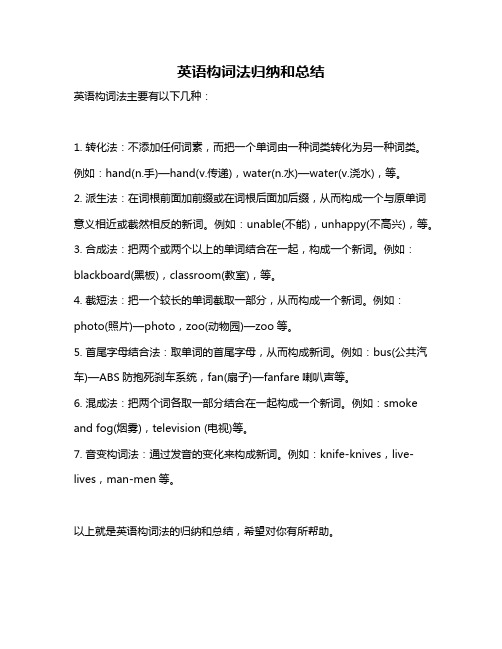
英语构词法归纳和总结
英语构词法主要有以下几种:
1. 转化法:不添加任何词素,而把一个单词由一种词类转化为另一种词类。
例如:hand(n.手)—hand(v.传递),water(n.水)—water(v.浇水),等。
2. 派生法:在词根前面加前缀或在词根后面加后缀,从而构成一个与原单词意义相近或截然相反的新词。
例如:unable(不能),unhappy(不高兴),等。
3. 合成法:把两个或两个以上的单词结合在一起,构成一个新词。
例如:blackboard(黑板),classroom(教室),等。
4. 截短法:把一个较长的单词截取一部分,从而构成一个新词。
例如:photo(照片)—photo,zoo(动物园)—zoo等。
5. 首尾字母结合法:取单词的首尾字母,从而构成新词。
例如:bus(公共汽车)—ABS防抱死刹车系统,fan(扇子)—fanfare喇叭声等。
6. 混成法:把两个词各取一部分结合在一起构成一个新词。
例如:smoke and fog(烟雾),television (电视)等。
7. 音变构词法:通过发音的变化来构成新词。
例如:knife-knives,live-lives,man-men等。
以上就是英语构词法的归纳和总结,希望对你有所帮助。
英语中的三种构词法

英语中的三种构词法学习构词法基础知识是非常有好处的,它可以使我们能够轻松认识更多单词,以一种巧妙的方式扩大词汇量,短期内记住更多的单词。
今天,就和小编一起来学习构词法的基础知识吧!英语中的构词法主要有三种,即转化法、合成法和派生法。
一. 转化法在英语中,一个单词由一种词性转化为另一种或几种词性而词形不变的方法叫做转化法。
1. 动词转化为名词●Let me have a try.让我试试。
●They are only allowed to sell soft drinks at school.在学校里只准许他们出售不含酒精的饮料。
2. 名词转化为动词●He shouldered his way through the crowd.他用肩膀推开人群前进。
●The smell from the kitchen made his mouth water.从厨房传来的气味使他流口水。
3. 形容词转化为动词●We will try our best to better our living conditions.我们要尽力改善我们的生活状况。
●They tried to perfect the working conditions.他们努力改善工作条件。
4. 形容词转化为名词●He didn’t know the difference between right and wrong.他不辨是非。
●The old in our village are living a happy life.我们村的老年人过着幸福的生活。
5. 形容词转化为副词●How long have you lived there?你在那儿住多久了?6. 个别词在一定场合中可转化为名词●Warm clothes are a must in the mountains.穿暖和的衣服到山区去是必须的。
●Life is full of ups and downs.人生有得意时也有失意时。
英语词汇学之构词法

Example
"self confidence" is a compound objective formed from the words "self" and "confidence"
Example
"upload" is a compound verb formed from the words "up" and "load"
Other examples
"download", "email", "Google"
Verb synthesis
Objective synthesis
ቤተ መጻሕፍቲ ባይዱ
Transforming verbs into nouns
Verb to noun transformation: In English, it is also common for verbs to transform into nouns This process is called conversion or zero differentiation For example, the verb "to run" can be transformed into the noun "run," which can refer to a single act of running or a race Other examples include "to jump" (from "leap"), "to swim" (from "swim"), and "to write" (from "script")
英语词汇构词法

英语词汇构词法(Word-formation)英语构词通常包括六种方法:转化法、派生法、合成法、混合法、截短法和首尾字母结合法。
一、英语词汇构词法之【转化法】英语构词法中把一种词性用作另一种词性而词形不变的方法叫作转化法,有的名词可以作动词,有的形容词可以作副词或动词。
1.动词转化为名词1)意思没有变化,例如:I think we'd better finish the talk now.我想我们的谈话最好现在结束。
2)意思有一定变化,例如:He is a man of strong build.他是一个体格健壮的汉子。
3)构成短语,例如:Let's have a look first. 我们先看一下吧。
2.名词转化为动词1)表示物体的,如:Have you booked the ticket?你订好票了吗?2)表示身体部位的,如:Hand in your papers please.请把你们的试卷交上来。
3)表示一类人的,如:She nursed her husband back to health.她看护丈夫,使他恢复了健康。
4)抽象名词,如:We breakfasted together.我们在一起吃了早餐。
3.形容词转化为动词少数形容词可以转化为动词。
例如:We will try our best to better our living conditions.我们要尽力改善我们的生活状况。
4.副词转化为动词有少数副词可以转化为动词。
例如:Murder will out.恶事终必将败露。
5.形容词转化为名词1)表示颜色的形容词常可转化为名词,如:The girl in black appears very beautiful.那个穿黑衣服的女孩子看上去非常漂亮。
2)一些形容词如old, young, poor, rich, wounded, injured等与the连用,表示一类人,作主语时,谓语用复数,如:We don't belong to the rich, but we don't belong to the poor, either. 我们不是有钱人,但我们也不是穷人。
英语四个构词法
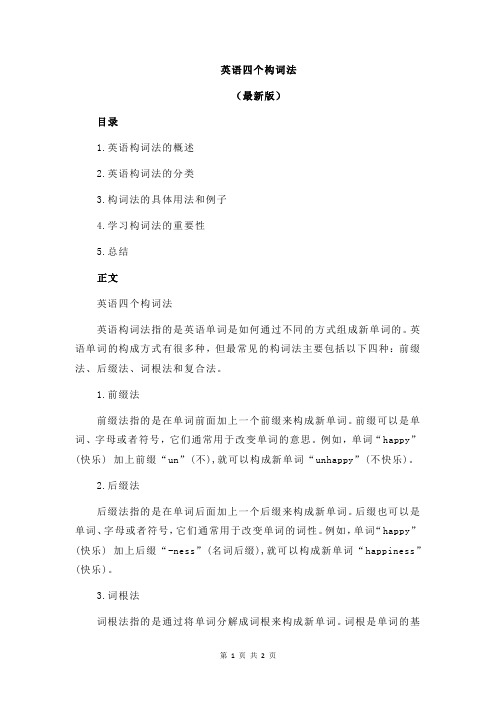
英语四个构词法(最新版)目录1.英语构词法的概述2.英语构词法的分类3.构词法的具体用法和例子4.学习构词法的重要性5.总结正文英语四个构词法英语构词法指的是英语单词是如何通过不同的方式组成新单词的。
英语单词的构成方式有很多种,但最常见的构词法主要包括以下四种:前缀法、后缀法、词根法和复合法。
1.前缀法前缀法指的是在单词前面加上一个前缀来构成新单词。
前缀可以是单词、字母或者符号,它们通常用于改变单词的意思。
例如,单词“happy”(快乐) 加上前缀“un”(不),就可以构成新单词“unhappy”(不快乐)。
2.后缀法后缀法指的是在单词后面加上一个后缀来构成新单词。
后缀也可以是单词、字母或者符号,它们通常用于改变单词的词性。
例如,单词“happy”(快乐) 加上后缀“-ness”(名词后缀),就可以构成新单词“happiness”(快乐)。
3.词根法词根法指的是通过将单词分解成词根来构成新单词。
词根是单词的基本部分,通常是一个或多个字母。
例如,单词“correct”(正确) 可以分解成词根“cor”(共同) 和“rect”(直),然后通过加上后缀“-ly”(副词后缀) 来构成新单词“correctly”(正确地)。
4.复合法复合法指的是将两个或多个单词组合在一起来构成新单词。
例如,单词“book”(书) 和“shop”(商店) 可以组合在一起构成新单词“bookshop”(书店)。
学习构词法对于学习英语非常重要。
它可以帮助我们更好地理解单词的意思和用法,并且可以帮助我们更容易地记住单词。
通过学习构词法,我们可以更好地掌握英语单词,提高我们的英语水平。
英语八大构词法
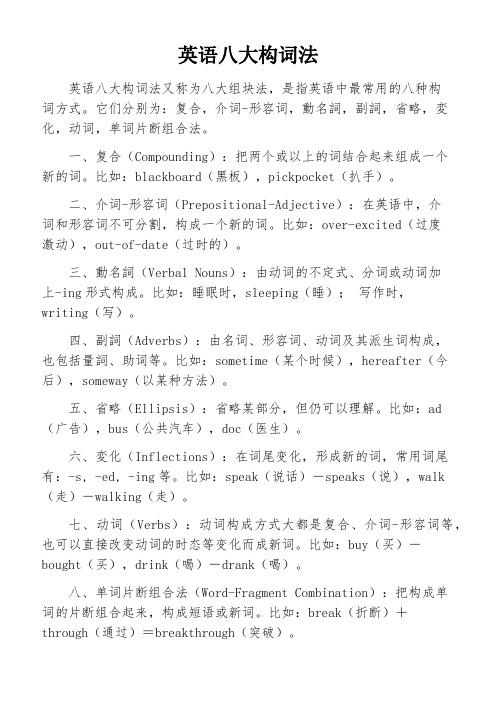
英语八大构词法英语八大构词法又称为八大组块法,是指英语中最常用的八种构词方式。
它们分别为:复合,介词-形容词,動名詞,副詞,省略,変化,动词,单词片断组合法。
一、复合(Compounding):把两个或以上的词结合起来组成一个新的词。
比如:blackboard(黑板),pickpocket(扒手)。
二、介词-形容词(Prepositional-Adjective):在英语中,介词和形容词不可分割,构成一个新的词。
比如:over-excited(过度激动),out-of-date(过时的)。
三、動名詞(Verbal Nouns):由动词的不定式、分词或动词加上-ing形式构成。
比如:睡眠时,sleeping(睡);写作时,writing(写)。
四、副詞(Adverbs):由名词、形容词、动词及其派生词构成,也包括量詞、助词等。
比如:sometime(某个时候),hereafter(今后),someway(以某种方法)。
五、省略(Ellipsis):省略某部分,但仍可以理解。
比如:ad (广告),bus(公共汽车),doc(医生)。
六、変化(Inflections):在词尾变化,形成新的词,常用词尾有:-s, -ed, -ing等。
比如:speak(说话)-speaks(说),walk (走)-walking(走)。
七、动词(Verbs):动词构成方式大都是复合、介词-形容词等,也可以直接改变动词的时态等变化而成新词。
比如:buy(买)-bought(买),drink(喝)-drank(喝)。
八、单词片断组合法(Word-Fragment Combination):把构成单词的片断组合起来,构成短语或新词。
比如:break(折断)+through(通过)=breakthrough(突破)。
英语八大构词法是一种有效的英语学习方法,使用者能够更全面、更系统的了解和掌握单词的构成方式和意思,从而更好地提高学习英语的效率。
词汇学之构词法课件

03
前缀的功能
前缀的主要功能是改变词根的意义或指示词的类别,例如"unhappy"中
的"un-"表示否定,"rebuild"中的"re-"表示再次或重复,"preheat"中
的"pre-"表示预先。
后缀
后缀的定义
后缀是一种构词成分,附加在词 根之后,用来改变词的意义或指
示词的类别。
常见的后缀
常见的英语后缀包括"-ness"( 表示性质或状态)、"-ful"(表 示充满或具有...的性质)、"-ly"
词汇学之构词法课件
contents
目录
• 构词法简介 • 派生构词法 • 合成构词法 • 转化构词法 • 缩略构词法 • 词汇学之构词法应用
01
构词法简介
什么是构词法
01
构词法是研究词汇变化和形成的 科学,它主要研究词素组合的方 式、词素替换的规则等。
02
构词法包括词根、前缀、后缀、 词尾等部分,它们通过不同的组 合方式形成新的词汇。
总结词
详细描述
总结词
详细描述
首字母缩略词是将一组词的首 字母组合成一个新词。
例如,“NASA”(美国国家 航空航天局)、“VIP”(重 要人物)等都是首字母缩略词。 这些词分别取自“National Aeronautics and Space Administration”和“Very Important Person”的首字母。
转化法
将一个词从一种词类转化为另 一种词类的方法。
截取法
从长词中截取一部分形成新词 的方法。
7种英语构词法(英语量化记忆法)
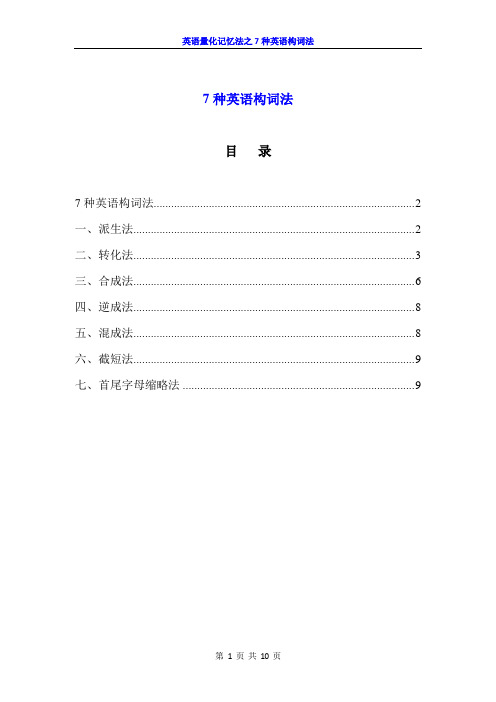
英语量化记忆法之7种英语构词法7种英语构词法目录7种英语构词法 (2)一、派生法 (2)二、转化法 (3)三、合成法 (6)四、逆成法 (8)五、混成法 (8)六、截短法 (9)七、首尾字母缩略法 (9)7种英语构词法一、派生法派生法:在一个单词的前面或后面加上词缀构成新词的方法,称为派生法。
派生构词有三大要素:词根、前缀和后缀。
也有人称之为两大要素:自由词素和粘附词素。
派生法的结构是:粘着词素+自由词素+粘着词素。
(一)英语词缀分成前缀和后缀两种。
前缀是加在词根或单词前面的部分。
它具有一定的含义。
同一词根或单词加上不同的前缀,即可构成不同的新词。
pre—(前):prewar (战前的)post—(后):postwar(战后的)im—(入):import (输入)前缀可以增加、改变或加强一个词根或单词的意义,也可以改变一个单词的词类。
如:增加意义:hemi-(半)→ hemisphere(半球)改变意义:un-(不)→ unhappy(不快乐的)加强意义:de-→ describe(描写)改变词类:en-(使)→ enlarge(扩大)前缀的意义主要有这几种:1、表示否定意义,如:anti-: anticancer抗癌剂2、表示数目和数量,如:multi-: multicolored多彩的3、表示时间、空间和程度,如:a-: aboard在船上4、表示特殊意义,如:auto-: autobiography自传后缀是加在词根或单词后面的部份。
后缀有四种,即:名词后缀、形容词后缀、动词后缀和副词后缀。
后缀不仅改变词的意义,而且使单词由一种词类转化成另一种词类。
1、名词后缀,如:表示人:-er: worker工人; teacher教师-ist: artist艺术家; chemist药剂师表示物:-or: tractor拖拉机; generator发电机-ant: disinfectant消毒剂; dependant依附物表示抽象名词:-hood: childhood童年; neighborhood邻居关系-ship: friendship友谊; horsemanship骑马术表示集合名词:-ry: peasantry农民总称; citizenry公民总称-age: mileage英里数; teenage十几岁的时期表示场所地点:-ery: piggery养猪场; greenery花房,温室-ern: saltern制盐场; cavern洞穴表示疾病:-oma: trachoma沙眼症; neuroma神经瘤-itis: bronchitis支气管炎; arthritis关节炎表示……学:-logy: zoology动物学; anthropology人类学-ics: electronics电子学; statistics统计学2、形容词后缀:表示一种事物具有或属于某种性质或状态。
现代英语词汇学概论--构词法

没膝深的 knee-deep 齐肩高的 shoulder-high 终身的 lifelong 晶莹剔透的 Crycle-clear 苦乐参半的 bittersweet 谈论的话题 talked-about topic 杜撰的故事 made-up story 24小时看守 round-the-clock watch 作现场勘查 make an on the sop inspection
2) denationalized denationalized = de + nation + al + ize + d Root: nation Stem: denationalize Base: national → nation nationalize → national denationalize → nationalize denationalized → denationalize
Combining forms are distinguished from affixes by their ability to occur as one constituent of a word whose only other constituent is an affix. e.g. autocracy hydrography telephone autocracy = auto [构词成分] + cracy (suffix) hydrography = hydro [构词成分] + graphy (suffix) telephone = tele [构词成分] + phone (suffix) From the point of view of derivation, no distinction should be made between combining forms and affixes in this book, in which all the combining forms are labeled either as prefixes or suffixes.
史上最全的构词法用法详解

史上最全的构词法用法详解史上最全的构词法用法详解构词法语言中词的总和构成词汇,但是词汇并不是一堆杂乱无章、互不相关的群体,而是一个严密体系,在这个结构的体系中,词与词之间有着各种各样的联系。
英语中的这些联系的规律总结起来就是构词。
英语中构词的方法就是构词法。
构词法主要有合成法、转化法、派生法和缩略法四种。
掌握构词法是迅速扩大词汇量的重要方法之一。
第一节合成法合成法就是指由两个或两个以上的单词合成的词叫合成词。
这种构词方式主要有两种:复合法、结合法。
合成法主要是构成合成名词和合成形容词。
复合法构成的复合词,它们各个结合的部分相互间的语法关系是紧密相关的。
如blackboard和darkroom都是形容词和名词形成的结构,writing desk是动词名词和名词形式的结构。
结合法形成的词是形态合成词,它的结合是用一个起来连接作用的中缀来把两个或两上以上的词根词素紧紧的连缀在一起。
如,用辅音字母-s-来缀全两个词根词素构成的词有:salesman, townspeople等。
合成的方式常见的有如下几种:一、合成名词1、名词/代词+名词:woman-doctor, women-doctors, workshop, spaceship, he-goat, coal fire, motorcycle, gas cooker, oil well, power plant, silk worm, gold mine, bottleneck, piano keys, telephone receiver, television screen, chairman, fireman, motorman, police-officer, postman, pine tree, girl friend, boy friend, goldfish, raindrop, birdcage, breakfast time, flowerbed, tearoom,2、动词+名词:blowpipe, flashlight, watchdog, call-girl, searchlight3、形容词+名词:blacksmith, blackboard, supermarket, superman, darkroom, blackbird, highchair, hothouse, greenhouse, madman4、动名词+名词:reading-room, sitting-room, classroom, schoolroom, dining room, building materials, dancing girl, cleaning women, flying machine, washing machine, working conditions, boilding point, drinking water, swimming pool, drinking cup, typing paper, writing desk, sewing machine, walking stick,5、名词+动名词:machine-building, shoe-making, paper-correcting, book-keeping, dressmaking, letter-writing, story-telling, town-planning, handwriting, sun-bathing, horse riding, churchgoing, daydreaming6、动词+副词:stand-by, take-off, cut-off, breakdown7、副词+名词:downfall, rainfall, outhouse8、现在分词+名词:running dog, running water, flying fish, rising sun, burning stick,9、名词+介词+名词:man-of-war, editor-in-chief,10、名词+连词字母+名词:handiwork, nowadays11、介词/副词+名词:afternoon, inland, overbalance二、合成形容词1、形容词+名词+ed:five-storeyed, one-eyed, double-faced, blue-eyed,2、名词+名词+ed:honey-mouthed,3、名词/代词+分词:man-made, heart-broken, self-educated, snow-covered, man-eating, peace-loving, paper-making, ocean-going, heartfelt, handmade, home-made, sunburnt, weather-beaten4、名词/代词+形容词:color-blind, ice-cool, seasick, airsick, tax-free, grass-green, snow-white, rock-hard, sea-green5、形容词/数词+名词:full-time, high-grade, second-hand,6、形容词/数词+分词:ready-made, sleepy-looking, good-looking,7、副词+分词:far-reaching, so-called, hard-working, far-reaching, well-meaning, newly-laid, well-meant, wide-spread8、副词+形容词:ever-green, under-ripe,9、形容词+形容词:dark-blue, red-hot, grey-green10、介词+名词:downhill, overnight三、合成副词1、形容词+名词:sometimes, meanwhile2、副词+名词:oftentimes, indoors, outdoors, overhead3、介词+名词:alongside, beforehand4、名词+形容词:skyhigh, stonestill,5、副词+介词:nearby, upalong,四、合成动词1、名词+动词:overhear, underline2、形容词+动词:moonwalk3、副词+动词:white-wash, safeguard五、其它合成词1、合成代词:everybody, everyone, everything, anyone, anybody, anything2、合成介词:outside, inside, throughout第二节转化法不用借助构词词缀,把一个单词从一种词类转化成另一种词类的方法就是转化法。
英语构词法的分类

英语构词法的分类
英语构词法是研究英语单词形成和构造规律的一门学科。
根据单词的构造方式和来源,可以将英语构词法分为以下几个分类:
1.派生法(Derivation):派生法是最常见的构词方式之一,通过在词根或词干前后加上前缀或后缀来形成新的单词。
例如,通过在词根“friend”前加上前缀“un-”,我们可以得到“unfriend”,意为“取消朋友关系”。
2.复合法(Compounding):复合法是将两个或多个独立的词组合在一起形成新单词的方式。
这些词可以是名词、动词、形容词等。
例如,“blackboard”(黑板)是由“black”(黑色)和“board”(板)组合而成的。
3.缩略法(Abbreviation):缩略法是将单词或词组的一部分缩短形成新的单词。
例如,“ad”(广告)是“advertisement”的缩略形式。
4.混合法(Blending):混合法是将两个或多个词的一部分合并来形成新的单词。
例如,“brunch”(早午餐)是由“breakfast”(早餐)和“lunch”(午餐)合并而成的。
5.借词法(Borrowing):借词法是指从其他语言中直接借用单词或词组。
英语中有很多借词,如“pizza”(比萨饼)来自意大利语。
6.转化法(Conversion):转化法是通过改变词性或词类来形成新的单词。
例如,“email”(电子邮件)可以作为名词使用,也可以作为动词使用。
以上是英语构词法的一些主要分类。
通过了解这些不同的构词方式,我们可以更好地理解和运用英语单词的形成规律。
英语10种构词法
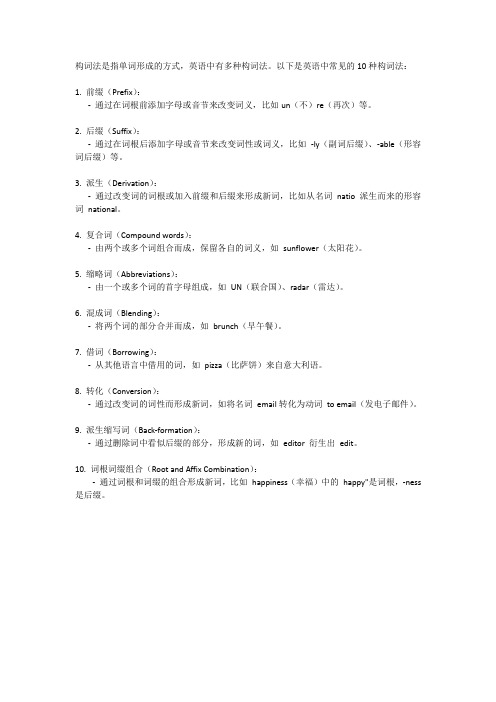
构词法是指单词形成的方式,英语中有多种构词法。
以下是英语中常见的10种构词法:
1. 前缀(Prefix):
- 通过在词根前添加字母或音节来改变词义,比如un(不)re(再次)等。
2. 后缀(Suffix):
- 通过在词根后添加字母或音节来改变词性或词义,比如-ly(副词后缀)、-able(形容词后缀)等。
3. 派生(Derivation):
- 通过改变词的词根或加入前缀和后缀来形成新词,比如从名词natio 派生而来的形容词national。
4. 复合词(Compound words):
- 由两个或多个词组合而成,保留各自的词义,如sunflower(太阳花)。
5. 缩略词(Abbreviations):
- 由一个或多个词的首字母组成,如UN(联合国)、radar(雷达)。
6. 混成词(Blending):
- 将两个词的部分合并而成,如brunch(早午餐)。
7. 借词(Borrowing):
- 从其他语言中借用的词,如pizza(比萨饼)来自意大利语。
8. 转化(Conversion):
- 通过改变词的词性而形成新词,如将名词email转化为动词to email(发电子邮件)。
9. 派生缩写词(Back-formation):
- 通过删除词中看似后缀的部分,形成新的词,如editor 衍生出edit。
10. 词根词缀组合(Root and Affix Combination):
- 通过词根和词缀的组合形成新词,比如happiness(幸福)中的happy"是词根,-ness 是后缀。
词汇学之构词法

Lexicology (Lecture Four)2011.9.22The structure of a wordWord is not an unanalysible unit, it can be analyzed. e.g. …M an‟can not be broken down into any smaller unit, but …manly‟ can. Word is the minimum free form (最小的自由使用单位).1. 词素morphemeMorpheme: the minimum meaningful unit. 最小的意义单位. There are two types of morphemes:Free morpheme: the morphemes that can occur alone可以独立使用, e.g. dog, nation, closeBound morpheme:the morphemes that cannot occur independently尽管能表达意义,但不能独立使用,至少要与另外的一个形位结合才能使用, e.g. the word distempered has three morphemes,namely, dis-, temper- and -ed, of which temper is a freemorpheme, dis- and -ed are two bound morphemes. Allomorph: 词素有变体,如自由词素take的变体为took和taken;粘着词素in-的变体为il-, im-, ir等。
2. Root and affixA root is the base form of word that can not further be analysed without total loss of identity. That is to say, it is the part of the word left when all the affixes are removed.Affix:affixes add meaning to the rootroots may be bound or free but affixes are always bound.Inflectional and derivational affixInflectional affix: They only carry relevant grammatical information. An inflectional affix serves to express such meanings as plurality, tense, and the comparative or superlative degree. e.g. plural. Thus,book and books are both nouns referring to the same kind of entity.Derivational affix: They are so called because when they are added to another morpheme, they “derive” a new word either by changing the meaning of the base to which they are attached or by changing the grammatical category (part of speech) of the base. The derivational affixes may be further classified as prefix and suffix.Example: The word "unbreakable" has three morphemes: "un-", a bound morpheme; "break", a free morpheme; and "-able", a free morpheme. "un-" is also a prefix, "-able" is a suffix. Both "un-" and "-able" are affixes.Summary:1.Words are composed of morphemes.2. Morphemes may be classified as free or bound.3. Morphemes can also be classified into roots and affixes.4 Affixes are classified into inflectional and derivational affixes. Derivational affixes are subdivided into prefixes and suffixes,Major types of word-building1. Affixation:a process in which a free morpheme is combined with a bound morpheme, a prefix or a suffix.Prefix: generally do not change part of speech of the word 不改变词的词性Suffix: change part of speech of the word2. ConversionConversion is also referred to as Zero Derivation.It is a process that can transfer a word belonging to one word class to another word class without any change of form, either in pronunciation or spelling.3. Compounding 复合法A word made in process which consists joining two or even more words to form anew entity. A compound is the result of the process of putting together two (or more) individual words to form a complex word.Compounding is perhaps the most common way of expanding the vocabulary of English. It allows users to combine two familiar words to form a new lexeme.4. Back-formation 逆生法Back-formation is process of word building by which elements are extracted from a complex word.Burglar---to burgleHelicopter---to helicoptMass-production—to mass-produceCozy---to cozeBrowbeaten---to browbeat5. Shortening 缩短法What we get from shortening is a lesser unit. There is a trend in modern English to shorten words. Three ways of shorteninga. ClippingThe process by which one part in a word of two or more syllables is cut without changing its function.Advertisement—adExamination---examb. initialism (abbreviation)words formed from the initial letters of words which are pronounced as sequences of letterse.g. EECc. acronymsformed by the initial letters but are pronounced as a word.e.g. UNESCO OPEC6. BlendingBlending is the process of combining the first element of the first word and the last element of the second word. Blends are originally created for comic effect.telecast (television broadcast)motel (motor hotel), hotel7. Onomatopoeia(making words by echoing a sound that is linked to the thing we want to name) Classification (by Stephen Ullmann英国语言学家、语义学家奠基人)Primary onomatopoeia (基本拟声词)Secondary onomatopoeia (次要拟声词)8. Words from Proper NamesAnother minor word-formation process is the creation of new words from proper names. The transition from proper names to common nouns is a gradual one.。
- 1、下载文档前请自行甄别文档内容的完整性,平台不提供额外的编辑、内容补充、找答案等附加服务。
- 2、"仅部分预览"的文档,不可在线预览部分如存在完整性等问题,可反馈申请退款(可完整预览的文档不适用该条件!)。
- 3、如文档侵犯您的权益,请联系客服反馈,我们会尽快为您处理(人工客服工作时间:9:00-18:30)。
10
常见前缀3—特定意思
构成方式
例词
anti-(反)
antiwar, anticancer, antipollution…
auto-(自动)
automatic, autotimer, autorecord…
bi-(双)
bicycle, binoculars…
centi-(百分之一的) centimeter, centigram,
12
常见后缀1—名词后缀
后缀
-ion -ist -ity -man
-ment -ness -or -ship -ure work
例词
action, decision, collection, creation… pianist, violinist, scientist, communist… equality, majority… fireman, policeman, chairman, Englishman… development, movement, arrangement… happiness, sadness, weakness… actor, sailor, visitor, director… friendship, leadership, ownership… pleasure, failure, pressure… homework, housework, schoolwork…
的
in-
informal, independent, injustice…
非正式的 独立的 不公正
ir-
irregular, irresponsible, irresistible…
不规则的 不负责任的 不可抗拒的
dis-
disadvantage, disorder, dislike…
缺点
杂乱
不喜欢
一、概念
通过加前缀或后缀构成一个新词的方法叫派生法。
二、方法 1. 加在前 unhappy, impolite, asleep, endanger… 2. 加在后 actor, hopeless, policeman, imagination… 3. 既加前又加后 unlucky, disagreement…
14
常见后缀2—形容词后缀
后缀 例词
-ful peaceful, careful, helpful, useful…
-ing exciting, convincing, interesting, amusing…
-ish Irish, selfish, foolish, childish…
-ive creative, active, attractive, effective…
电视 肺结核 贵宾 世界贸易组织
世界卫生组织 联合国
NATO
OPEC UFO
UNESC O …
北约 石油输出国组织 不明飞行物 联合国教科文组织
20
结语
谢谢大家!
13
常见后缀2—形容词后缀
后缀
-able
-al -an -ant -ed -en -ent
-ic
例词
valuable, miserable, comfortable, loveable… national, original, cultural, logical…
American, African, Korean, Canadian…
centigrade…
co-(共同)
co-operate, co-edit, co-exit…
down(向下)
downstairs, downhill, downwards…
ex-(以前的)
ex-wife, ex-lover, ex-
11
常见后缀1—名词后缀
后缀
-an -ance -ation -dom -ence -er -ese -ess -hood -ian
三、类别 1. 前缀(一般只改变词义,不改变词性) 2. 后缀(一般只改变词性,不改变词义)
8
常见前缀1—改变词类
构成方式
a. a-加在名词前构成形容词或副词
b. be-加在名词或形容词前构成动词
例词
asleep, aboard, aside…
睡着的 在船上 在旁边
befriend, bewitch, b帮e助head…蛊惑 砍头
hand(手)
hand(递)
warm(温暖 的)
back(后背) back(支持) dirty(脏的)
warm(热) dirty(弄脏)
spy(间谍) spy(监视) lower(更低 lower(降低) 的)
18
其它构词法之截短法
截前
telephone
aeroplane helicopter
截后
-less careless, homeless, endless, useless…
-ly
friendly, lovely, lively, early…
-ous nervous, dangerous, furious, famous…
-some lonesome, tiresome, troublesome, handsome…
f全u职ll-的time头, f等ir的st-clas冰s,冷ic的e-co全ld新,的 brand-new
t两w小o时-h的our户, o外u的t-doo上r,山u的p-h透ill明, s的ee-
6
合成副词和合成代词
构成方式
合 成 副 词
例词
empty-handed, single-handed,
-y
rainy, windy, dirty, cloudy…
15
常见后缀3—副词动词数词后缀
后缀
例词
副词后缀 clearly, finally, usually, luckily…
动词后缀 widen, sharpen, simplify, notify, memorize, apologize…
动名词+名词
waiting-room, writing-desk, sleeping bag..
动词+名词
pickpocket, turn-coat, sleepwalker…
副词+名词
income, overcoat, inland…
代词+名词
he-goat, she-wolf…
名词+介词+名词 father-in-law, editor-in-chief…
4
合成动词
构成方式
名词+动词
副词+动词
例词
sleepwalk, waterski, daydream,
sunbathe…
梦游
滑水
做白日梦 沐日
光浴
overcome, overeat, upload, uphold…
克服
吃太多 上传 维护
形容词+副词 whitewash, quick-charge, blacklist, i刷ll-白treat… 快速充电 列入黑名单 虐
例词
Asian, American, Russian, African… attendance, performance, assistance… education, examination, pronunciation… freedom, kingdom, wisdom, boredom… difference, preference, existence… diver, writer, dancer, reporter… Chinese, Japanese, Portuguese… actress, princess, goddess, hostess… childhood, neighborhood, motherhood… magician, musician, historian…
c. em-加在名词前构成动词 d. en-加在名词前构成动词 e. en-加在形容词前构成动词
e使m从b事ark,使e嵌m入bed使, 能够 empower…
危及
鼓励
endanger, encourage…
使富裕 扩大 使亲密
enrich, enlarge,
endear…
智胜
比…多
9
常见前缀2—构成反义
hand 3. 由两个分开的词构成 black list, black sea, black
sheep 三、类别
1. 合成名词 2. 合成动词
3
合成名词
方式
例词
名词+名词
football, notebook, seafood, hand-book...
形容词+名词
blackboard, first-class, green house…
plant(浇灌) plant(植物) push(推) push(推)
kiss(亲吻) kiss(吻) walk(步行) walk(散步)
17
转化法2(conversion)
名词转化为动词
形容词转化为动词
book(书) book(订) calm(镇静的) calm(平静)
seat(座位) seat(就坐) slow(缓慢的) slow(减慢)
截前后
advertisemen refrigerator
t
examination fridge
kilogram
influenza
bicycle
veterinarian laboratory mathematics
19
其它构词法之缩写法
